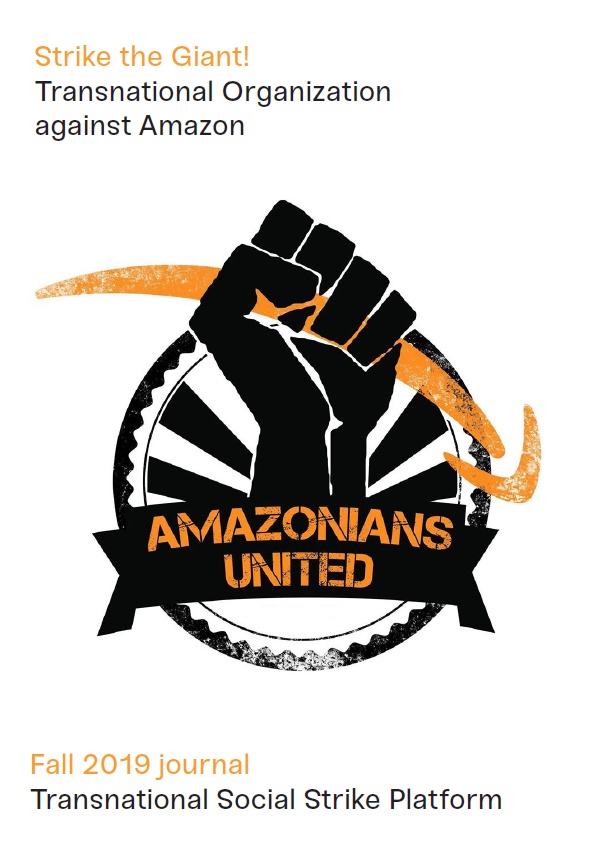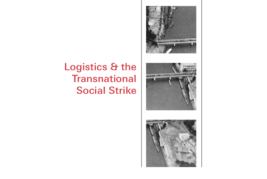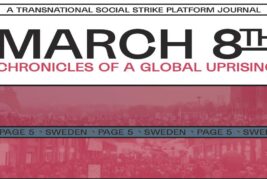
by TRANSNATIONAL SOCIAL STRIKE PLATFORM
Download the whole pdf at this link: https://www.transnational-strike.info/app/uploads/2019/11/Strike-the-Giant_TSS-Journal.pdf
This year Amazon will receive an unexpected gift for Black Friday. On this day of transnational mobilization against Amazon, the TSS platform publishes the collected voices of Amazon workers and activists in struggle across the world. After many strikes and actions in Madrid, Bad Hersfeld, Portland, Piacenza, Lille, Poznan, Shakopee, and many other plants, an assembly of Amazon workers from European and North American warehouses gathered took place in Leipzig, Germany, in September 2019. «We want to strike together for common demands», they say in their final declaration, «despite all of our differences, we are united by the fact that we are facing a common employer. […] Only when united do we have a chance to effectively assert our interests against Amazon». Amazon workers’ transnational meetings started in 2015, when Polish and German workers began to talk to each other as a direct response to the opening of the first Amazon Fulfillment Center (FC) in Poland, aimed at supplying the German market in case of disruption and for absorbing the effects of strikes in Germany. As Christian from Bad Hersfeld says in this journal, in these first meetings «we realized that we have the same problems, that Amazon treats us the same way but also uses the different labor laws of our countries against us all».
Since then the bonds have tightened and more people from Poland, Germany, Spain, France, Slovakia and the US have joined the meetings. Started as a way to know each other and have a sense of the different and yet interrelated working conditions and legal frameworks, these discussions went further than simple exchange of experiences. Notwithstanding the company’s efforts to portray its management as visionary and keep its working places out of labor disputes, in fact, Amazon’s warehouses have been struck by strikes and protests almost everywhere. From these struggles, workers concluded that fighting for local gains is not enough: the growing sense of the need to face the global dimension of Amazon and its complex logistical network led workers to agree on developing a transnational strategy against the company. The final declaration adopted after the meeting in Leipzig is the first visible result pointing at the challenge of elaborating a common strategy and demands across borders. Something new is being attempted: there is not an already established model to be followed, no ready-made solutions. Transnational organization needs to be invented.
This TSS journal collects some of the voices that, from different locations, are discussing how to build this common strategy, what are the tools at hand and what are the goals to be met. The articles in the journal show the novelty of this attempt and the magnitude of challenges we confront when facing a global company such as Amazon. The idea to compose this journal derives from our belief that this discussion involves not only those who are working and struggling within Amazon, but all those who want to act and organize on a transnational level. The stakes go well beyond the company itself. In discussing a common strategy for the first time Amazon workers pose the problem of how to organize against global chains of production, that is, against global command over labor. Together with Amazon workers, the TSS journal reflects on how to build a stable and effective communication across the borders and how to overcome the fragmentation that today seems to make it impossible to build a collective force against employers. Moreover, this experiment poses serious questions to everyone, on the forms of organization that we can use to make our local struggles transnational. Amazon workers are indeed very clear about the need to push trade unions beyond their limits as national structures, in so far as they can be obstacles rather than tools to produce and maintain a political communication across borders. Therefore, the articles raise the problem of organization in a new way that is relevant for everyone: they do not highlight the need of founding a new formal structure, a “union of unions”, but rather to expand and deepen communication by putting pressure on the existing organizations from below in order to overcome workers’ division into sectors, union membership, collective contracts, race and sex. As the French comrades say «from a trade union point of view, this requires us to rethink our role within companies, to assume the limits of trade union action and structure. We should support workers to organize themselves transnationally».
One of the main tools highlighted by the contributions to build a shared strategy is to endorse common demands concerning wages, working conditions and contracts. These demands should serve to enhance transnational communication in FCs globally and to overcome the different labor legislations, the diverse regulations concerning collective agreements, minimum wages, social benefits, or the fiscal, economic and legal privileges granted to Amazon by each state. This is no easy task since Amazon relies heavily on these differences to prevent workers from building a common force. Amazon’s strategy is to negotiate only with specific unions, limit concessions to some warehouses, grant permanent contracts or benefits only to specific groups of workers, raise wages in one place and simultaneously cut them elsewhere, hinge on institutional racism to blackmail migrant workers. All Amazon workers face the same lack of safety, high risk of injuries, physical and mental exhaustion. In delivery centers fumes from cars and trucks accumulate in buildings, putting the health of the pickers at danger. All Amazon workers are allowed too short breaks too rarely, can barely talk to each other, are constantly pressured to meet unreachable standards. Yet, while imposing similar working conditions, Amazon exploits local differences to break workers’ capacity to organize. The first task of a transnational organization against Amazon is to overthrow its capacity to take advantage of different political, social and legal conditions to produce fragmentation among workers.
Amazon does indeed research on local conditions – distance to customers, average wage, availability of a poor workforce and migrant labor – in order to decide where to open a warehouse. Besides bargaining with those public administrations eager on creating a “business friendly environment”, Amazon builds «facilities where there are guaranteed exploitable workers», as Brian from the Portland Delivery Center writes. Amazon established centers in the poorest areas of Portland where mostly migrants live, and unemployment rates are higher. Amazon’s recruiting strategy aims at assuring a disposable and flexible mass of poor laborers that can quickly deliver goods to the customers. At the same time, it reinforces racial and social hierarchies: as William from Shakopee FC (Minnesota) states, Amazon recruits «immigrants for its workforce, while at the same time hiring former or current military officers for their management. This creates a distinct hierarchy within the warehouse». In the Shakopee warehouse the preference goes to newly arrived East-African migrants, who are supposedly more apt to endure bad conditions without complaining. Somali migrants resoundingly gave the lie to this assumption as they came to the forefront of the first Amazon strike in Minnesota last summer. In Poland, Ukrainian seasonal workers, non-unionized and very mobile, are by now a stable component of the workforce. Moreover, racial hierarchy adds to a very clear sexual hierarchy: while many pickers and stowers are women, managers and supervisors are mostly men. This implies that, in designing its distribution network, Amazon relies on a whole set of political and social conditions to define the best location for its warehouses and to produce hierarchies among workers inside each of them.
Besides this, there is a detailed production of internal differences through contracts. In all Amazon warehouses a high percentage of workers have short-term contracts, even weekly contracts as in Spain. In France more than half of the workers have fixed-term contracts. Existing collective agreements, when in force, are constantly circumvented by hiring through external providers or temp agencies. Amazon employs precarious workers not only to face fluctuations of sales, but also because it is clearly more difficult for these workers to join the strikes under the threat of losing their job. Moreover, the possibility of layoffs is used to put pressure on temp workers and compel them to meet higher and higher standards, which are then applied to all workers. The articles show that, while the fight for permanent contracts and for collective agreements would enhance the capacity to struggle and to have a say on work standards, it is difficult to conclude that the sole goal of the struggle can be that each warehouse signs its own collective contract. In the US, for example, collective contracts almost always imply a “no strike” clause. As Brian from Portland states, the permanent contract is thus not the ultimate goal of the whole struggle, because for building an effective organization the «contract would become a burden rather than an aid».
Amazon also uses wage levels to divide workers and break the strike fronts. In Madrid the management offered advantages and pay-rises to some workers during the strikes with the clear goal «to divide those who strike from those who don’t and to create oppositions». While Amazon wages are usually slightly above the regional average to attract the workforce, the company constantly plays with the different wage parts – direct wage, bonuses, benefits, overtime pay – so that wage raises often correspond to cuts in bonuses or increases in work time or performance rates. When talking about Amazon’s decision to raise the minimum wage in the US to 15$, William states that «the consequences were mixed, because when they raised the minimum wage they also took away the monthly bonuses that we used to get, based on productivity in our building and on individual worker attendance». Amazon administers wages both to divide workers and to increase intensity of labor. The problem is therefore how to address the issue of wage transnationally by contesting the possibility that through wage policies workers can be pitted against each other, or that pay raises can be “paid” with higher work intensity and less money after all.
These are the most relevant elements of a complex situation that requires a decisive innovation in terms of transnational strategy and organizing. Against extreme fragmentation, gaining concessions just for some categories of workers means reinforcing hierarchies based on sex, race, contract type, wage level, benefit allowances and location. Common demands need to cope with the fragmentation of social and political conditions of exploitation and the necessity of overthrowing those hierarchies within as well as outside of the warehouse. While starting from the conditions of Amazon workers, we think the articles included in this journal are extremely useful to address the challenge of organizing transnationally against what we have called the “logistics of exploitation”. Here as elsewhere, the priority is to build bridges between different conditions. Amazon – this sort of seemingly invincible global giant – utilizes differences and divisions to avoid that its employees – more than half a million workers worldwide – can unite against one very rich guy in Seattle. But what is our way to Seattle? How can we accumulate power along the way? What are our tools?
«The biggest challenge is to gain more power and to organize a majority of the Amazon workers worldwide. We have to overcome the idea, that this struggle can be won on a local base» as Christian from Bad Hersfeld states. Expanding workers’ connections and communication, as the journal’s contributors maintain, is the first step. For the specific form of production of a global supply chain, no fulfillment center is closer to Seattle than the other: in order to hit the core of this system, organization needs to spread and expand in time and space to confront the dispersed elements that sustain it. Consequently, the transnational strike against Amazon emerges from the articles as a movement and a project, rather than an isolated event or simply a coordinated single day of strike, after which everyone goes back to business as usual. Transnational organization changes local practices by making them part of a common long-term project. Thinking the strike as a movement means that it includes several different practices. In order to counteract Amazon’s attempt to divert flows of goods during a strike, workers in Germany are using the “tactic of needle sticks”, «which includes non-announced strikes, variation of duration and number of FCs involved in Germany, “fake strikes”, in-out-in-strike, a strike out of the running business and spontaneous strikes in case of high volume of orders». The employment of this tactic has disturbed the smooth flow of packages and has forced Amazon to use extra resources to cope with unpredicted strikes. In Poland, where legislation makes legal strike very hard, Amazon workers organize slowdowns and strike ballots: «we collect votes, drive around magazines, talk to employees – we use the referendum to agitate in the canteens, inside the magazines, where we distribute leaflets, speak through the trade union’s speakers, thanks to which more and more people from different magazines join us». Assemblies, marches, sit-ins, slowdowns, “needle-sticks”, blocks, picket lines, any possible method to relieve oneself at work: the transnational strike is all these practices, in so far as they are not isolated, but go in the direction of accumulating power and enlarging the capacity to organize.
The transnational strike is a political project: recognizing the current difficulty and huge obstacles to organize worldwide does not equate to weakness or compliance, but to the beginning of transnational organizing itself. In this framework any clear-cut opposition between symbolic and real strikes loses its meaning and no formal structure can claim a monopoly on the “true and real strike”. If one was to support this opposition, it would have to mean that one was prepared to downgrade the ambitious attempt of addressing the challenges of transnational organizing as simply symbolic. The global women’s strike has shown us very clearly in these last years that this distinction does not hold true. Each coordinated action, each strike makes the process grow and intensifies the mutual communication. Each action when placed in a common project contributes to the common transnational strategy, which in turn reinforces local organization.
The transnational strike as a movement and a project needs common demands to be endorsed across borders. Against the “dream” of optimized exploitation organized by Amazon, common demands are the tools to enlarge our potential, to trigger a more intense communication and to fight together despite the differences. Common demands are not simply concrete points to be presented on the table of a supposedly transnational negotiation, but, rather, tools to be used for advancing faster on our way to Seattle. They are the tools to start speaking a common language, to recognize each other in a common fight. In this direction, the demand of an equal wage for all Amazon on a global scale (which is currently being discussed) is an enormous wager. As TSS we think that this wager is to be made. As the French comrades say, this «is a demand that forces workers to conceive themselves transnationally» and allows to counteract the administration of wage differentials and contract hierarchies used by Amazon. We believe that an equal wage for all Amazon workers cannot be reduced to a “realistic” calculation or a specific amount of money, measured according to purchasing power or national minimum wages, that are themselves a way to increase fragmentation. Its concreteness lies in the radical quest for equality that it contains, and not in how accurately it is measured, how rationally it fits with the different legislations or how scientifically it is tailored on the different types of contracts. It is concrete because it brings further the construction of a common front.
As the Polish comrades say «while a few years ago it was unimaginable to mention that we want to earn the same as colleagues from Germany (then most would laugh that it was pious wishes or shrug their shoulders), today there is more and more room for criticism of wage inequality in Europe. After all, our work is the same as in Germany». Claiming an equal wage gives us the measure of the power that we can exercise against Amazon on a global scale, something that was unconceivable until little time ago. For this reason, the equal wage is crucial not simply for those who are struggling within Amazon. The equal wage could express a shared and strong commitment to equality against divisions and subordination, to that equality that Amazon as well as all other employers negate every day. Demanding an equal wage means to collectively reject the political command over work that (not only) Amazon exercises by imposing hierarchies and differences aimed at increasing exploitation. In relation to this, the crucial question, central to everyone who is striving to organize on a transnational level, is whether existing organizations and unions will be ready to make space for the transnational strike as a project and a movement, to «think bigger» and overcome national limits. As the final declaration from Leipzig states «we only have one life and we cannot wait»: the urgency of this task cannot be overlooked.





